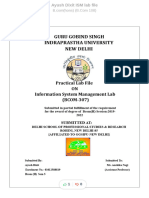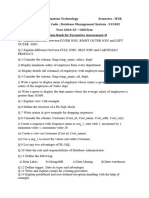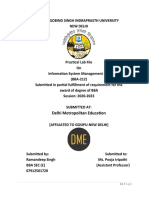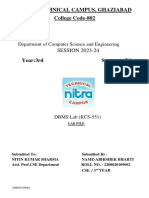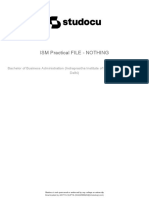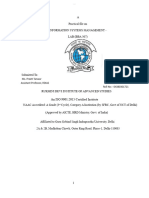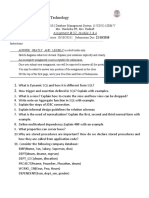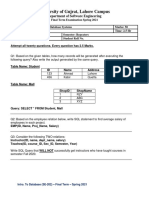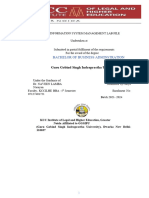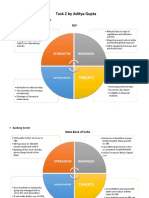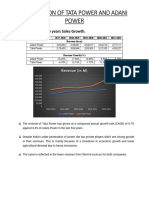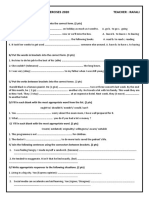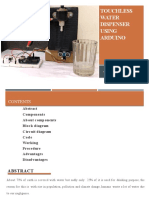Management Information System Assignment File
Management Information System Assignment File
Uploaded by
ADITYA GUPTACopyright:
Available Formats
Management Information System Assignment File
Management Information System Assignment File
Uploaded by
ADITYA GUPTACopyright
Available Formats
Share this document
Did you find this document useful?
Is this content inappropriate?
Copyright:
Available Formats
Management Information System Assignment File
Management Information System Assignment File
Uploaded by
ADITYA GUPTACopyright:
Available Formats
lOMoARcPSD|20475450
Management information system assignment file
B.com(hons) (Guru Gobind Singh Indraprastha University)
Studocu is not sponsored or endorsed by any college or university
Downloaded by ADITYA GUPTA (00424588820@jimskalkaji.com)
lOMoARcPSD|20475450
GURU GOBIND SINGH
INDRAPRASTHA UNIVERSITY
NEW DELHI
Practical Lab File
ON
Information System Management Lab
(BBA-212)
Submitted in partial fulfillment of the requirement
for the award of degree of BBA(G)
Session:2019-2022
SUBMITTED AT:
DELHI SCHOOL OF PROFESSIONAL STUDIES & RESEARCH
ROHINI, NEW DELHI-85
[AFFILIATED TO GGSIPU-NEW DELHI]
Submitted By: Submitted To:
Kunal Agrawal Ms. Anshika Negi
Enrolment No.- 03512501719 (Assistant Professor)
BBA Sem 4
Downloaded by ADITYA GUPTA (00424588820@jimskalkaji.com)
lOMoARcPSD|20475450
INDEX
S.NO. CONTENT Pg No. T.SIGN
01 Introduction of SQL and Data type 3
02 SQL DDL commands 4
03 SQL DML commands 5
04 Q.No.4 6
05 Q.No.5 7
06 Q.No.6 8-10
07 Q.No.7 11-13
08 Q.No.8 14-16
09 ER Modelling and Symbols of ER 17
10 Diagram of Organisation 18
11 Diagram of Banking System 19
12 Diagram of Hostipal Management 20
System
13 Diagram of University 21
Downloaded by ADITYA GUPTA (00424588820@jimskalkaji.com)
lOMoARcPSD|20475450
Question 1: Introduction to SQL. Explain what are different types of data types in SQL.
Ans . SQL stands for Structured Query Language. It is designed for managing data in a relational
database management system (RDBMS).It is pronounced as S-Q-L or sometime See-Qwell. SQL
is a database language, it is used for database creation, deletion, fetching rows, and modifying
rows, etc. SQL is used to create new databases, tables and views. It is used to insert records in a
database. It is used to update records in a database. It is required to delete records from a
database. It is required to retrieve data from a database.
Different types of Data Types in SQL
1) CHAR- A fixed length string (can contain letters , numbers, and special characters). The size
parameter specifies the column length in characters can be from 0 to 255. Default is 1.
2) VARCHAR - A variable length string (can contain letters, numbers, and special characters).
3) BOOLEAN - The BOOLEAN data type supports the storage of two values TRUE AND
FALSE.
4) INTEGER- The INTEGER data type accepts numeric values with an implied scale of zero.
5) DECIMAL - The DECIMAL data type accepts numeric values, for which you may define a
precision and a scale in the data type declaration.
6) FLOAT - The FLOAT data type accepts approximate numeric values, for which you may
define a precision up to a maximum of 64. If no precision is specified during the declaration, the
default precision is 64. Attempting to assign a value lager than the declared precision will cause
an error to be raised.
Downloaded by ADITYA GUPTA (00424588820@jimskalkaji.com)
lOMoARcPSD|20475450
Question 2: EXPLAIN SQL DDL COMMANDS. With Syntax and Examples.
Ans . Data Definition language is one of the subcategories of SQL. It is used to define and work
with the database structure. This includes the attributes within each table, the name of each table,
the name of the database and the connection of keys between tables.
1) CREATE COMMAND- used to create the databases, the tables, and the columns within each
table. Within the create statement we also define the data type of each column. A data type is
literally the type of data we are supposed to store within each column, whether it be an integer, a
date, or a string.
Syntax- CREATE TABLE TABLE_NAME(Attribute_name1 Data type, Attribute_name2 Data
type );
Example- CREATE TABLE STUDENT(Name Varchar(50), Age int);
2) ALTER COMMAND- used to alter existing database structures. This includes adding
columns and more.
Syntax- ALTER TABLE TABLE_NAME ADD COLUMN Attribute_name Data type;
Example- ALTER TABLE STUDENT ADD COLUMN Last Name varchar(50);
3) DROP TABLE COMMAND- This is used to destroy your database or table.
Syntax- DROP TABLE TABLE_NAME;
Example- DROP TABLE STUDENTS;
4) RENAME- This is used to rename.
Syntax- RENAME TABLE OLD_TABLE_NAME TO NEW_TABLE_NAME;
Example- RENAME TABLE Students TO Students1;
Downloaded by ADITYA GUPTA (00424588820@jimskalkaji.com)
lOMoARcPSD|20475450
Question 3: EXPLAIN SQL DML COMMANDS. With Syntax and Examples
Ans . Data Manipulation Language is used to work with the actual data within the database. If
we looked at an example with a users table, the table is created with DDL while the value “Caleb
Curry” is entered using DML.
1) SELECT- This is used to select data from our database. We first SELECT AND then we say
what columns to select. After we say what columns, we specify what tables using FROM. After
we select what columns and what tables we can limit our results using a WHERE clause.
Syntax- SELECT * from TABLE-NAME, WHERE CLAUSE.
2) INSERT INTO- This is used to change values.
Syntax- INSERT INTO TABLE_NAME VALUES(Value1, value2…);
Example- INSERT INTO STUDENT values (01,’Umesh’,25);
3) DELETE- This is used to delete values(the database structure stays the same, only inserted
values are removed).
Syntax- delete from table_ name where clause.
Example-delete from STUDENT where Name=’Umesh’;
4) UPDATE- This is used to change values.
Syntax- Update Table_Name SET Attribute_Name=Value where CLAUSE;
Example- Update STUDENT SET Name=Amit where p_id=05;
Downloaded by ADITYA GUPTA (00424588820@jimskalkaji.com)
lOMoARcPSD|20475450
Question 4: Create table customer(c_id, c_name, address, city, pincode, country) insert atleast
10 values. Display the table.
Downloaded by ADITYA GUPTA (00424588820@jimskalkaji.com)
lOMoARcPSD|20475450
Question 5: Create table named employee containing columns
(emp_id,emp_name,emp_desig,dob,emp_sal,emp_dept) insert 10 atleast values
Constraints applied on employee table
1.emp_id should be primary key
2.emp_sal should not contain any null value
3.emp_desig should be unique
Downloaded by ADITYA GUPTA (00424588820@jimskalkaji.com)
lOMoARcPSD|20475450
Question 6: Create employee table
A. EID,ENAME,DESG,BRANCH,SALARY,ADDRESS.
B. INSERT 10 RECORDS
C. Salary column should not contain any null value
D. Salary should be between 5000-35000
E. ENAME should be unique
Perform various SQL Commands.&Display Table
I. Add column in above table date of joining, experience
II. Display the table
III. Complete the table definition
IV. Delete the column DESG
V. Find out details of employee whose salary is above 25000.
VI. Find out details of employee order by salary
VII. Calculate total number of records in employee table
VIII. List employees whose salary is between 10000-30000.
Downloaded by ADITYA GUPTA (00424588820@jimskalkaji.com)
lOMoARcPSD|20475450
Downloaded by ADITYA GUPTA (00424588820@jimskalkaji.com)
lOMoARcPSD|20475450
Downloaded by ADITYA GUPTA (00424588820@jimskalkaji.com)
lOMoARcPSD|20475450
Question 7: Create the following table AND PERFORM SQL COMMANDS STUDENT
(ROLL_NO, NAME, AGE, COURSE, MARKS).
1) Select * from student where age is > 18 & course = MBA
2) List name of student where name like (%%i)
3) Find out total number of records in table
4) Find out name, course, marks from student order by marks asc.
5) Display name and course of student
6) Find the student with max marks
7) List the names of students order by Roll_No in des. Order.
8) Find out the average of all the marks. Display it as average_marks.
Downloaded by ADITYA GUPTA (00424588820@jimskalkaji.com)
lOMoARcPSD|20475450
Downloaded by ADITYA GUPTA (00424588820@jimskalkaji.com)
lOMoARcPSD|20475450
Downloaded by ADITYA GUPTA (00424588820@jimskalkaji.com)
lOMoARcPSD|20475450
Question 8: Create the following tables. Insert atleast 10 records in each.
A. Supplier (s_no, sname, status, city)
B. Parts (p_no, pname, color, weight, city)
Answer the following queries in SQL
1) Find the supplier for city = Delhi
2) Find all supplier whose name start with “ab%”
3) Find all suppliers whose status is 10, 20 or 30
4) Find total number of city of all suppliers
Downloaded by ADITYA GUPTA (00424588820@jimskalkaji.com)
lOMoARcPSD|20475450
Downloaded by ADITYA GUPTA (00424588820@jimskalkaji.com)
lOMoARcPSD|20475450
Downloaded by ADITYA GUPTA (00424588820@jimskalkaji.com)
lOMoARcPSD|20475450
Downloaded by ADITYA GUPTA (00424588820@jimskalkaji.com)
lOMoARcPSD|20475450
Question 10: Draw Entity Relationship diagram of an Organisation.
Downloaded by ADITYA GUPTA (00424588820@jimskalkaji.com)
lOMoARcPSD|20475450
Question 11: Draw Entity Relationship diagram of a Banking System
Downloaded by ADITYA GUPTA (00424588820@jimskalkaji.com)
lOMoARcPSD|20475450
Question 12: Draw Entity Relationship diagram of a Hospital Management System.
Downloaded by ADITYA GUPTA (00424588820@jimskalkaji.com)
lOMoARcPSD|20475450
Question 13: Draw Entity Relationship diagram of a University.
Downloaded by ADITYA GUPTA (00424588820@jimskalkaji.com)
You might also like
- Ayush Dixit Ism Lab File - CompressDocument21 pagesAyush Dixit Ism Lab File - Compresstushar rawatNo ratings yet
- Ism Lab FileDocument22 pagesIsm Lab FileTushar GaurNo ratings yet
- DBMS Lab Manual 2020-21 PDFDocument83 pagesDBMS Lab Manual 2020-21 PDFchandana ARNo ratings yet
- DMS - Question Bank THFA-IIDocument2 pagesDMS - Question Bank THFA-IIsg10836666No ratings yet
- SQL Interview Questions and Answers GDocument67 pagesSQL Interview Questions and Answers GnageshNo ratings yet
- Assignment 3 Linda ZhuDocument12 pagesAssignment 3 Linda Zhuapi-433437278No ratings yet
- ADBTLab Manua115-16Document45 pagesADBTLab Manua115-16EdenNo ratings yet
- ISM LAB FILE by RamanDocument35 pagesISM LAB FILE by RamanRAMANDEEPNo ratings yet
- Mit802 2013 2014Document3 pagesMit802 2013 2014threeletasNo ratings yet
- Lab File: Information Systems Management (BBA-305)Document22 pagesLab File: Information Systems Management (BBA-305)synestergates822No ratings yet
- DBMS Lab FileDocument25 pagesDBMS Lab FilearangkumargiriNo ratings yet
- Assignment-2 MODULE-3:: DBMS-18CS53Document3 pagesAssignment-2 MODULE-3:: DBMS-18CS53neelagundNo ratings yet
- cs8481 DBMS Lab ManualDocument134 pagescs8481 DBMS Lab ManualK RUKESH90% (10)
- Quiz AnPSiDocument2 pagesQuiz AnPSiWi ChenNo ratings yet
- ADBMSDocument6 pagesADBMSKaushik GhoshNo ratings yet
- Ism Practical File NothingDocument84 pagesIsm Practical File NothingADITYA GUPTANo ratings yet
- Prac Ques DbmsDocument3 pagesPrac Ques Dbmsshinde.aastha311No ratings yet
- DBMS LAB Manual PDFDocument40 pagesDBMS LAB Manual PDFNitin UpadhyayNo ratings yet
- Super 25 DMA Questions by Rajan Sir V2VDocument3 pagesSuper 25 DMA Questions by Rajan Sir V2Varnavkarangutkar123No ratings yet
- ADBMS Assignment FinalDocument6 pagesADBMS Assignment Finalchamod tharushaNo ratings yet
- DBMS Lab File 2023-24 Cse - 074538Document20 pagesDBMS Lab File 2023-24 Cse - 074538Aadarsh PandeyNo ratings yet
- Dbms Lab Manual RGPVDocument38 pagesDbms Lab Manual RGPVKiruthikaNo ratings yet
- Day PI QuestionsDocument9 pagesDay PI QuestionsVIKAS KUMARNo ratings yet
- Practical Workbook-1Document11 pagesPractical Workbook-1NainNo ratings yet
- DMS Practice QuestionDocument2 pagesDMS Practice QuestionRavi PawarNo ratings yet
- Information System Management Lab File Bba 5th SemDocument19 pagesInformation System Management Lab File Bba 5th SemYavi GuptaNo ratings yet
- Advanced Oracle SQL Tutorial - With SOLNSDocument11 pagesAdvanced Oracle SQL Tutorial - With SOLNSIan SeepersadNo ratings yet
- Self Test SQLDocument12 pagesSelf Test SQLSwapnil MahajanNo ratings yet
- NNilesh DBMSDocument60 pagesNNilesh DBMShamiscamNo ratings yet
- Dbms Lab Manual RGPVDocument38 pagesDbms Lab Manual RGPVcsedepartmentsistecr100% (3)
- DBMS Lab FileDocument25 pagesDBMS Lab FileAkshat kumarNo ratings yet
- Practical File-2Document40 pagesPractical File-2vanshgtotNo ratings yet
- Dbms Lab Manual RGPVDocument38 pagesDbms Lab Manual RGPVcsedepartmentsistecrNo ratings yet
- Internship ReportDocument31 pagesInternship ReportPriyanshu AgrawalNo ratings yet
- Jyot DBMSDocument43 pagesJyot DBMShamiscamNo ratings yet
- SQL Interview Questions For A BA JobDocument10 pagesSQL Interview Questions For A BA Jobravitejabandhakavi29No ratings yet
- DBMS Lab File 2022-23Document21 pagesDBMS Lab File 2022-23JatinNo ratings yet
- C Byregowda Institute of TechnologyDocument2 pagesC Byregowda Institute of Technologypriya shashikumarNo ratings yet
- Data Science: Part 2 - SQLDocument13 pagesData Science: Part 2 - SQLHimanshu Patidar100% (1)
- DBMS Lab - Manual Dec 15, 2020Document22 pagesDBMS Lab - Manual Dec 15, 2020harshNo ratings yet
- Ddbms Lab ManualDocument100 pagesDdbms Lab Manualgezahegn mulusewNo ratings yet
- SQL Query Interview Questions and AnswersDocument14 pagesSQL Query Interview Questions and AnswersRaghu GowdaNo ratings yet
- SQL Lab Manual Guide MaterialsDocument15 pagesSQL Lab Manual Guide MaterialsBirhanu WorkuNo ratings yet
- Xii Sample Practical File 2024Document30 pagesXii Sample Practical File 2024Sreyash BaishkhiyarNo ratings yet
- Intro To DB (SE-202) Final Spring 2021Document4 pagesIntro To DB (SE-202) Final Spring 2021Mustanser NasirNo ratings yet
- Cs 502 Lab Manual FinalDocument27 pagesCs 502 Lab Manual FinalAmit Kumar SahuNo ratings yet
- 45 Essential SQL Interview Questions: Hire A Developer Apply As A Developer Log inDocument48 pages45 Essential SQL Interview Questions: Hire A Developer Apply As A Developer Log inhari hNo ratings yet
- DBMS QBDocument4 pagesDBMS QBmd shakil ahsan mazumderNo ratings yet
- QuestionBank LabPractcalsDocument12 pagesQuestionBank LabPractcalsSujal PatelNo ratings yet
- Ism Lab FileDocument59 pagesIsm Lab FileShivam RanjanNo ratings yet
- XII - IP - Practical - List 2023-24Document4 pagesXII - IP - Practical - List 2023-24Mayank BansalNo ratings yet
- Experiment Name: Experiment No: 1 Remark Date SignDocument18 pagesExperiment Name: Experiment No: 1 Remark Date SignSneha BadheNo ratings yet
- DBMS Lab ManualDocument42 pagesDBMS Lab ManualNiteshNo ratings yet
- SQL Query Interview QuestionsDocument7 pagesSQL Query Interview QuestionsShruthi KommuNo ratings yet
- Practice QuestionsDocument3 pagesPractice Questionsstynx784No ratings yet
- What Is Sql ?: Fundamentals of Sql,T-Sql,Pl/Sql and Datawarehousing.From EverandWhat Is Sql ?: Fundamentals of Sql,T-Sql,Pl/Sql and Datawarehousing.No ratings yet
- Beginning Microsoft SQL Server 2012 ProgrammingFrom EverandBeginning Microsoft SQL Server 2012 ProgrammingRating: 1 out of 5 stars1/5 (1)
- Ind - Aus RelationsDocument4 pagesInd - Aus RelationsADITYA GUPTANo ratings yet
- Ind-South Africa RelationsDocument6 pagesInd-South Africa RelationsADITYA GUPTANo ratings yet
- EVS - Unit 1 - EcosystemsDocument21 pagesEVS - Unit 1 - EcosystemsADITYA GUPTANo ratings yet
- INDIA-ARGENTINA RelationsDocument6 pagesINDIA-ARGENTINA RelationsADITYA GUPTANo ratings yet
- Evs Air & Noise PollutionDocument11 pagesEvs Air & Noise PollutionADITYA GUPTANo ratings yet
- Evs Unit1 ResourcesDocument14 pagesEvs Unit1 ResourcesADITYA GUPTANo ratings yet
- Task 4 Aditya GuptaDocument9 pagesTask 4 Aditya GuptaADITYA GUPTANo ratings yet
- Analysing On The Recruitment and Selection Process of Employees of Finploy TechnologiesDocument10 pagesAnalysing On The Recruitment and Selection Process of Employees of Finploy TechnologiesADITYA GUPTANo ratings yet
- Task 2 SWOT AnalysisDocument5 pagesTask 2 SWOT AnalysisADITYA GUPTANo ratings yet
- Task 3 by Aditya GuptaDocument7 pagesTask 3 by Aditya GuptaADITYA GUPTANo ratings yet
- Ism Practical File NothingDocument84 pagesIsm Practical File NothingADITYA GUPTANo ratings yet
- IUCN Global Standard For Nature-Based SolutionsDocument31 pagesIUCN Global Standard For Nature-Based SolutionsDraco RuborNo ratings yet
- Blowfish Algorithm With Examples - GeeksforGeeksDocument27 pagesBlowfish Algorithm With Examples - GeeksforGeeksxativiy256No ratings yet
- Q RQ9194engDocument15 pagesQ RQ9194engdddcvNo ratings yet
- Contextualization That Is Authentic and Relevant: by David J. HesselgraveDocument5 pagesContextualization That Is Authentic and Relevant: by David J. HesselgraveJacob JuliannNo ratings yet
- Plasma Television Teachers - : When A Different Reality Takes Over African EducationDocument18 pagesPlasma Television Teachers - : When A Different Reality Takes Over African EducationObsaa IliyaasNo ratings yet
- Review Bac. Language Exercises 2020 Teacher: RafaliDocument1 pageReview Bac. Language Exercises 2020 Teacher: RafaliFATIMZAHRA RAFALINo ratings yet
- ECT Level 3Document66 pagesECT Level 3rf85ahmadi100% (1)
- Pc43t Parts CatalogDocument7 pagesPc43t Parts CatalogjackNo ratings yet
- Revealed Preference Theory EconomicsDocument4 pagesRevealed Preference Theory EconomicsInaam Ullah BalochNo ratings yet
- Product Line Up 2020: Specifications SpecificationsDocument2 pagesProduct Line Up 2020: Specifications Specificationsrobin wideproNo ratings yet
- Touchless Water Dispenser Using ArduinoDocument17 pagesTouchless Water Dispenser Using ArduinoVarne VinayNo ratings yet
- Slip Gauge Pg-1 PDFDocument1 pageSlip Gauge Pg-1 PDFaliNo ratings yet
- Statement 0305202205080370Document4 pagesStatement 0305202205080370Arjun KumarNo ratings yet
- PDF e Banking Project On Sbi CompressDocument26 pagesPDF e Banking Project On Sbi CompressPawanNo ratings yet
- PDF WTP - 18 September 2023Document3 pagesPDF WTP - 18 September 2023Agus WibowoNo ratings yet
- OutsourcingDocument22 pagesOutsourcingSanju DurgapalNo ratings yet
- Thesis Political ScienceDocument54 pagesThesis Political ScienceKa MiNo ratings yet
- InvoiceDocument2 pagesInvoicerahul.kishore8No ratings yet
- Ebp (Evidence-Based Practice)Document11 pagesEbp (Evidence-Based Practice)TrishaNo ratings yet
- Concept Paper: Effects of Cheating As An Impeding Problem To The Academic Performances of Senior High School StudentsDocument5 pagesConcept Paper: Effects of Cheating As An Impeding Problem To The Academic Performances of Senior High School StudentsMichal VillanuevaNo ratings yet
- WCS - Chapter 06 - Sol HintsDocument7 pagesWCS - Chapter 06 - Sol HintsWorldNo ratings yet
- Anchor Study MaterialDocument10 pagesAnchor Study MaterialSunil S I ShippingNo ratings yet
- 9438-Article Text-30532-1-10-20201219Document12 pages9438-Article Text-30532-1-10-20201219MEGA SARINo ratings yet
- Cambridge International AS & A Level: Biology 9700/22 May/June 2022Document21 pagesCambridge International AS & A Level: Biology 9700/22 May/June 2022Patience BhebheNo ratings yet
- Document ControllerDocument2 pagesDocument ControllerHabib UllahNo ratings yet
- Lampkins Digital Citizen ProjectDocument27 pagesLampkins Digital Citizen Projectapi-242604347No ratings yet
- ThermochemistryDocument13 pagesThermochemistryludihemicarNo ratings yet
- Valve World Magazine June 2023Document88 pagesValve World Magazine June 2023Krishna KumarNo ratings yet
- 13152/kolkata Express Sleeper Class (SL)Document2 pages13152/kolkata Express Sleeper Class (SL)Akram MohithNo ratings yet
- Document Type Definition (DTD) : Well-FormedDocument12 pagesDocument Type Definition (DTD) : Well-Formedkanna karthik reddyNo ratings yet
